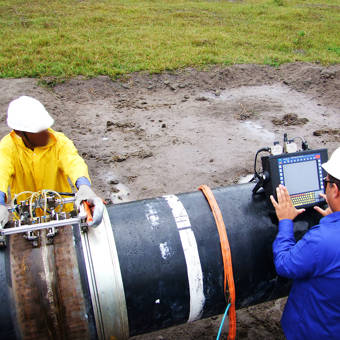Quality Assurance Ensured: Expert Pipeline Welding Inspection Solutions
Comprehensive Summary of Pipeline Welding Inspection Treatments
In the realm of pipeline building, guaranteeing the honesty and security of welded joints is paramount. Pipe welding examination treatments play a crucial function in guaranteeing that welded connections fulfill rigorous sector standards and requirements. From meticulous pre-welding examinations to detailed post-weld evaluations, a distinct evaluation process is crucial for preserving the structural stability of pipelines. Understanding the complexities of welding evaluation treatments is not only a governing requirement yet likewise a fundamental facet of upholding the integrity of these important frameworks.
Pre-welding Examination Preparations
Prior to beginning the welding process, detailed pre-welding assessment prep work are crucial to make sure the integrity and high quality of the weld joint. These prep work involve a meticulous examination of the products to be welded, the welding devices, and the work environment. By conducting thorough pre-welding evaluation preparations, potential issues can be determined and solved early on, leading to premium and reputable weld joints.
Welding Treatment Credentials
Comprehensive pre-welding examination prep work lay the structure for the essential process of Welding Procedure Credentials, guaranteeing the stability and high quality of the weld joint. Welding Treatment Certification (WPQ) is an essential action in the welding procedure that includes testing and licensing welding treatments to guarantee they satisfy certain standards and demands. The WPQ procedure usually consists of welding procedure spec advancement, welding procedure certification testing, and documentation of the outcomes.
During welding procedure specification development, necessary information such as the welding process, welding products, joint design, and welding criteria are defined to create an extensive treatment. Ultimately, welding procedure qualification screening is performed to validate the suggested treatment's stability. This screening typically includes welding examination vouchers that undergo numerous mechanical and non-destructive tests to analyze the weld's top quality and adherence to the specified standards.
In-process Weld Assessment
During the welding process, in-process weld assessment plays an important role in making certain the top quality and honesty of the weld joint - Pipeline Welding Inspection. This kind of examination involves monitoring the welding specifications, examining the weld grain development, and finding any possible problems or interruptions as they happen. By carrying out in-process weld evaluations, welding drivers can immediately address any issues that may develop, consequently making certain and protecting against additional defects that the last weld fulfills the called for requirements
Usual techniques used for in-process weld examination consist of aesthetic assessment, fluid penetrant testing, magnetic fragment screening, ultrasonic screening, and radiographic testing. Aesthetic inspection is usually the very first step while doing so, permitting assessors to aesthetically evaluate the weld for surface area abnormalities such as fractures, porosity, or insufficient blend. Extra advanced techniques like ultrasonic screening and radiographic testing provide in-depth check here understandings into the inner structure of the weld, making certain that there are no concealed flaws that might jeopardize the weld joint's toughness and integrity. In general, in-process weld inspection is necessary for preserving the top quality and reliability of welded pipes.
Non-destructive Screening (NDT)
Non-destructive Screening (NDT) is a crucial technique utilized in pipe welding inspection to evaluate the integrity of weld joints without causing damages to the welded structure. By utilizing various NDT techniques, assessors can assess the top quality of welds and identify any defects or suspensions that may endanger the structural soundness of the pipeline. Common NDT approaches made use of in pipe welding assessment include Radiographic Screening (RT), Ultrasonic Screening (UT), Magnetic Fragment Checking (MPT), Liquid Penetrant Screening (LPT), and Visual Screening (VT)
RT involves the use of X-rays why not find out more or gamma rays to create images of the internal structure of the weld, enabling assessors to identify defects such as porosity, cracks, or insufficient fusion. Furthermore, VT entails visual examination of welds to identify any noticeable blemishes.
Post-weld Assessment and Documents


Paperwork of post-weld inspection searchings for is important for keeping quality assurance records and making certain conformity with market requirements and laws. In-depth records should consist of information regarding the inspection methods used, the place and nature of any kind of defects located, and any restorative activities taken - Pipeline Welding Inspection. Correct documents not only serves as a document of the weld's quality however likewise aids in future maintenance and inspection procedures
Final Thought

Finally, pipeline welding assessment treatments play a crucial duty in making certain the top quality and stability of welds. From pre-welding evaluations to post-weld documentation, each action is important in preserving the safety and security and performance of pipelines. By following well established procedures and performing thorough examinations, possible problems can be determined and attended to prior to they result in pricey repairs or failings. On the whole, adherence to correct assessment methods is vital to the success of pipeline welding projects.
From careful pre-welding examinations to extensive post-weld analyses, a well-defined inspection procedure is crucial for preserving the structural strength of pipelines. By carrying out in-process weld assessments, welding operators can without delay address any concerns that may arise, thus stopping more problems and making sure that the last weld fulfills the needed specs.
Typical methods utilized for in-process weld assessment include aesthetic examination, fluid penetrant testing, magnetic particle testing, ultrasonic testing, and radiographic testing.Non-destructive Screening (NDT) is an important technique utilized in pipe welding examination to examine the integrity of weld joints without triggering damage to the welded structure. Post-weld assessment involves various methods to evaluate the welds for issues, including visual assessment, color penetrant screening, magnetic fragment testing, ultrasonic testing, and radiographic screening.